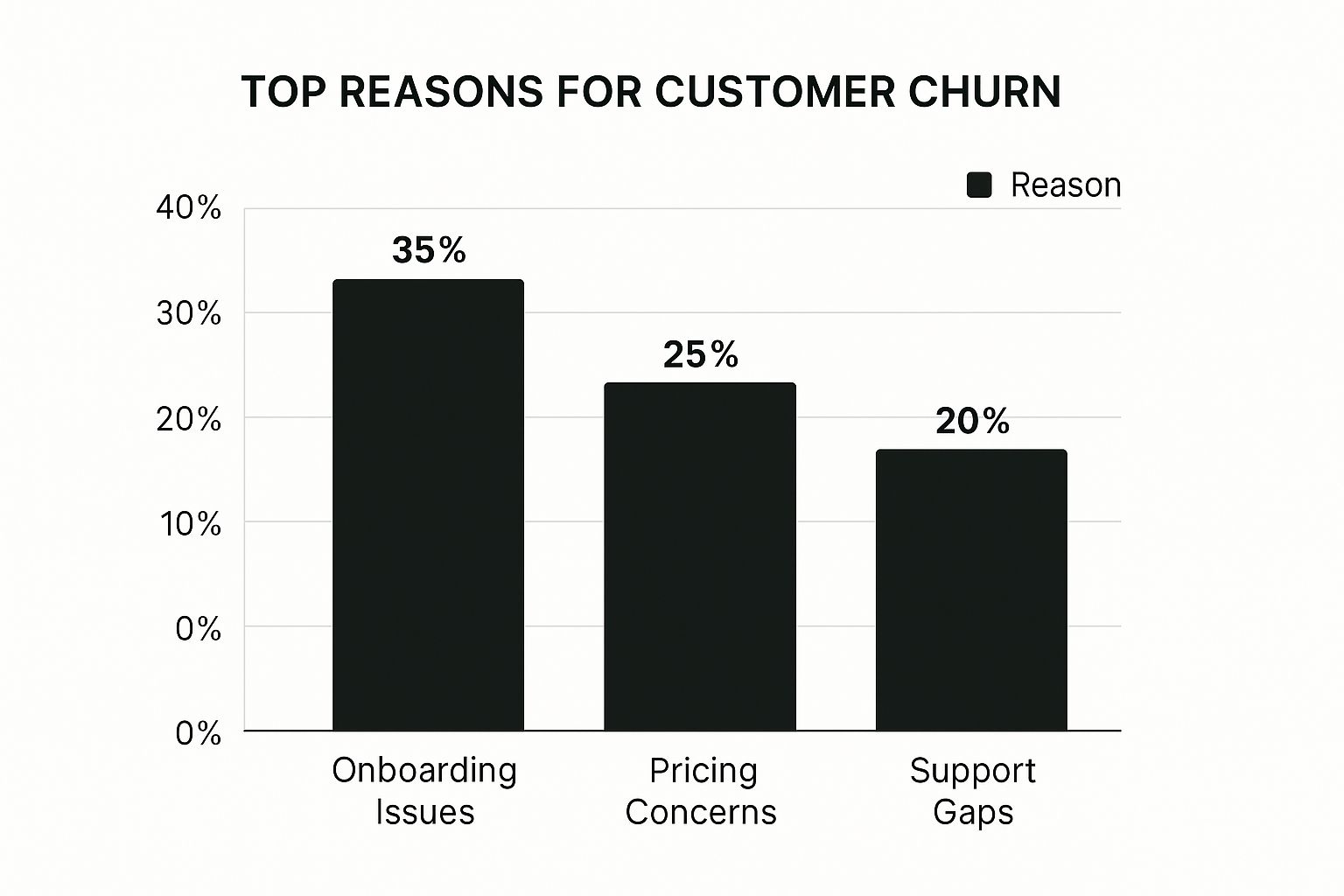The True Cost of Customer Churn: Beyond Lost Revenue
Losing a customer isn't just about a single lost sale; it sets off a chain reaction that impacts your entire business. Beyond the immediate hit to your revenue, customer churn creates hidden costs that can seriously stifle growth. This means businesses need to shift their focus. Instead of just acquiring new customers, prioritizing the retention of existing ones is key.
The Financial Burden of Churn
One of the most obvious costs of churn is the loss of potential future revenue. This becomes especially clear when you consider Customer Lifetime Value (CLTV), which is the total revenue a customer generates throughout their relationship with your business. When a customer churns, you lose not just the immediate sale, but also all the potential future purchases they would have made.
High churn rates also mean you have to spend more on acquiring new customers, which can be 5-25x more expensive than retaining existing ones. This creates a costly cycle where you're constantly investing in new customer acquisition just to replace the customers you’ve lost.
Beyond the Balance Sheet: The Intangible Impacts
The effects of customer churn go beyond just the financial. For example, high churn rates can negatively impact team morale. Employees who constantly see customers leaving may feel discouraged, which can lower their productivity and engagement. This, in turn, can lead to even more churn, creating a downward spiral.
A high churn rate can also damage your brand’s reputation. Dissatisfied customers are likely to share their negative experiences, and that can influence other potential buyers.
The hospitality, travel, and restaurant industries, for example, have significant retention challenges. As of 2025, they see an average customer retention rate of just 55% (meaning a 45% churn rate). This is often due to factors like price sensitivity and inconsistent experiences. In contrast, industries like media and professional services have an 84% retention rate. Customer service quality is a major factor, with 60% of consumers saying it’s key to their loyalty. Explore this topic further.
To provide further context on industry benchmarks, let's take a look at the data in the following table.
Industry Retention Rate Comparison: Comparison of customer retention rates across different industries to help businesses benchmark their performance
| Industry | Average Retention Rate | Average Churn Rate | Key Churn Drivers |
|---|---|---|---|
| Hospitality, Travel, & Restaurants | 55% | 45% | Price sensitivity, inconsistent experiences |
| Media & Professional Services | 84% | 16% | Competition, changing client needs |
| SaaS | Varies widely | Varies widely | Product complexity, lack of ongoing value |
| E-commerce | Varies widely | Varies widely | Price competition, shipping costs |
| Subscription Boxes | Varies widely | Varies widely | Lack of perceived value, competition |
This table highlights the significant differences in retention rates across various industries. This data emphasizes the need to consider industry-specific factors when analyzing churn and developing retention strategies.
Visualizing the Impact: Churn Rate by Industry
To illustrate the different impacts of churn across industries, let’s examine the following data chart, visualizing average customer churn rates across key sectors.

As the chart shows, sectors like SaaS and E-commerce usually have lower churn rates than areas like Hospitality or Subscription Boxes. This underscores the importance of industry benchmarks when setting churn reduction goals. Understanding these industry-specific patterns helps businesses allocate resources strategically and craft targeted approaches to minimize customer churn and maximize growth.
Spotting the Warning Signs Before Customers Leave

Customers rarely disappear without a trace. They often leave clues, hinting at their possible departure. Recognizing these subtle signs is the first step in reducing customer churn. Understanding shifts in customer behavior is key. For instance, fewer logins to a SaaS platform can indicate waning interest.
Declining Engagement: A Red Flag
Decreased product usage is a major red flag. If customers are using your product or service less frequently, it’s time to investigate. This could be fewer logins, less frequent purchases, or reduced interaction with your content.
Changes in support tickets can also be revealing. More technically-focused or frustrated support requests could indicate difficulty using your product. Actively monitoring support interactions is therefore crucial for identifying churn risks.
Understanding Behavioral Thresholds
Different industries have different benchmarks for customer behavior. What's normal in one sector could be a problem in another. Understanding these industry-specific behavioral thresholds is essential.
For example, a sudden drop in app usage for a daily food delivery service might be a stronger churn indicator than a similar drop for a monthly subscription box. Knowing these nuances helps prioritize retention efforts.
Generational differences also matter. Generational loyalty gaps reveal retention risks: 44% of Boomers abandon brands after one bad experience, compared to 24% of Gen Z. This highlights the need for age-specific retention tactics. Find more detailed statistics here.
To better illustrate these industry-specific warning signs, the table below provides a breakdown of key indicators and recommended interventions:
Understanding these industry nuances helps focus your retention strategy. Let's explore some key warning signs and how to address them effectively.
Churn Warning Signs by Industry
Key behavioral indicators that signal potential customer churn across different business sectors
| Industry | Primary Warning Signs | Monitoring Metrics | Recommended Intervention Timing |
|---|---|---|---|
| SaaS | Decreased login frequency, Reduced feature usage, Fewer support requests | Login rates, Feature usage metrics, Support ticket volume | Immediately following a sustained decline in activity |
| E-commerce | Fewer purchases, Abandoned shopping carts, Decreased website visits | Purchase frequency, Cart abandonment rate, Website traffic | After a noticeable drop in purchase activity or website engagement |
| Subscription Boxes | Skipped deliveries, Declining customer reviews, Increased unsubscribe requests | Delivery skip rate, Customer satisfaction scores, Unsubscribe rate | After a skipped delivery or a negative review, before the next billing cycle |
| Mobile Gaming | Reduced playtime, Fewer in-app purchases, Lowered engagement with community features | Daily/monthly active users, In-app purchase revenue, Community forum activity | After a significant drop in playtime or in-app purchases |
This table provides a starting point for identifying potential churn. Tailoring these metrics to your specific business is essential for accurate prediction and proactive intervention.
Building an Early Warning System
Developing an early warning system is crucial for proactive intervention. This means tracking key metrics and setting up alerts for deviations from the norm. Such a system enables your team to address potential churn risks promptly, transforming data into actionable insights.
By identifying at-risk customers early, you have a better chance of retaining them. This proactive approach is more effective than exit interviews after customers leave.
Building Customer Experiences That Prevent Churn
Preventing customer churn isn't just about improving your service. It requires a fundamental shift in how you design the entire customer journey. This means building experiences that create genuine loyalty and address the root causes of customer dissatisfaction.
Identifying and Eliminating Friction Points
Think of the customer journey like a road trip. A smooth, enjoyable ride keeps passengers happy. A bumpy road full of potholes leads to frustration. Similarly, friction points in the customer experience, such as a complicated checkout process or unresponsive customer support, can drive customers away. Leading companies systematically identify and eliminate these friction points.
One effective way to uncover these pain points is through customer journey mapping. This involves visualizing each step a customer takes, from initial awareness to ongoing engagement, and pinpointing areas where they might encounter difficulties.
You might be interested in: How to master marketing referral program ideas to further enhance customer acquisition and retention.
Gathering Honest Customer Feedback
To truly understand why customers leave, you need honest feedback. Traditional surveys often fail to capture the full picture. Customers may tell you what they think you want to hear. Instead, consider using methods like in-depth customer interviews and user testing to gain deeper insights.
These qualitative approaches allow you to explore the reasons behind customer behavior, revealing hidden frustrations and unmet needs. For example, through user testing, you might discover that a seemingly minor design flaw in your app is causing significant frustration for some of your users.
Creating Seamless Omnichannel Experiences
Today's customers interact with businesses across multiple channels: websites, apps, social media, and more. A seamless omnichannel experience is crucial for reducing churn. This means ensuring consistency and context across all touchpoints.
Imagine a customer starts a conversation with your support team on chat and then calls a few hours later. A seamless omnichannel experience would allow the phone representative to access the chat history and pick up where the previous interaction left off. This eliminates the need for the customer to repeat themselves, significantly reducing frustration.
Personalization: Making Customers Feel Valued
Personalization plays a vital role in churn reduction. Customers want to feel understood and valued, not like just another number. This means tailoring your communications, offers, and product recommendations to their individual needs and preferences.
Personalized email marketing, for example, has been shown to significantly improve open and click-through rates. By segmenting your audience and sending targeted messages, you can increase engagement and build stronger relationships. This makes the customer experience more relevant and enjoyable, ultimately increasing the likelihood of customer retention. Beyond email, personalization can extend to product recommendations, website content, and even in-app experiences, creating a truly customized customer journey.
The following table provides a framework for improving customer experience and reducing churn. It outlines the key stages of the customer experience, common pain points at each stage, methods for assessing those pain points, strategies for improvement, and the expected impact of those strategies.
Customer Experience Improvement Framework
Step-by-step approach to identifying and resolving customer experience issues that lead to churn
| Experience Stage | Common Pain Points | Assessment Methods | Improvement Strategies | Expected Impact |
|---|---|---|---|---|
| Awareness | Difficulty finding information about products/services | Website analytics, social media listening | Improve SEO, create targeted content | Increased website traffic, higher lead generation |
| Consideration | Confusing pricing, lack of product information | Customer surveys, competitor analysis | Simplify pricing structure, provide detailed product descriptions | Higher conversion rates, improved sales |
| Purchase | Complicated checkout process, limited payment options | User testing, A/B testing | Streamline checkout, offer multiple payment gateways | Reduced cart abandonment, increased order value |
| Onboarding | Lack of clear instructions, difficulty using the product/service | Customer support tickets, user feedback | Develop comprehensive onboarding materials, offer personalized support | Improved product adoption, higher customer satisfaction |
| Retention | Lack of engagement, poor customer service | Customer churn surveys, social media monitoring | Implement loyalty programs, proactively address customer issues | Reduced churn rate, increased customer lifetime value |
This framework highlights the importance of a holistic approach to customer experience. By addressing pain points at each stage of the customer journey, businesses can create a more positive and engaging experience that fosters loyalty and reduces churn.
From Reactive Support to Proactive Customer Success

The most effective way to minimize customer churn isn't by reacting to existing problems, but by preventing them in the first place. This requires a shift from reactive support to a proactive customer success strategy. Think of it like healthcare; treating symptoms is essential, but preventing illness through proactive, healthy habits is always preferable. This section explores how to build a customer success function that truly fosters strong partnerships with your customers.
Onboarding For Long-Term Retention
The customer journey starts with onboarding. A well-designed onboarding experience lays the foundation for long-term customer success and significantly reduces churn. This involves setting clear expectations from the outset and guiding customers toward achieving early wins. For example, a SaaS company might provide interactive tutorials and personalized support during the initial product setup phase.
Driving these early wins is critical. These quick victories demonstrate the value of your product or service, increasing the likelihood of continued use and mitigating the risk of early churn. This could involve helping customers accomplish a specific goal within their first week of using the product.
Developing Customer Health Scores
Just as doctors use vital signs to assess a patient's health, businesses can use customer health scores to evaluate the strength of their customer relationships. These scores combine various key metrics.
These metrics include product usage patterns, customer satisfaction feedback, and overall engagement signals to create a comprehensive picture of each customer's health.
For example, a declining product usage pattern combined with negative customer feedback might suggest a high churn risk. This allows your team to proactively intervene and address the potential issues before they escalate into bigger problems. Like a doctor recognizing the early warning signs of a disease, early intervention is vital.
Meaningful Business Reviews: Strengthening Relationships
Regular business reviews offer a structured approach to connecting with customers, reinforcing relationships, and identifying new expansion opportunities. These meetings shouldn't just focus on reporting metrics.
Instead, they should emphasize understanding your customer’s overarching business goals and how your product or service can help them achieve those objectives.
These reviews can also reveal opportunities for upselling or cross-selling, which naturally reduces churn risk. Customers actively expanding their product usage are less likely to leave. Furthermore, these regular interactions cultivate stronger, more resilient relationships. This, in turn, increases the overall customer lifetime value. These strategic conversations build a sense of real partnership, evolving beyond simple transactional interactions toward more valuable, strategic collaborations.
Leveraging Data Intelligence to Reduce Customer Churn
Smart data analysis is the driving force behind successful churn reduction. Leading companies are proactive, using predictive analytics to identify at-risk customers before they even think about leaving. This section explains how they do it.
Building Effective Churn Prediction Models
Building effective churn prediction models doesn't require a data science degree. Start by identifying the key factors that correlate with churn in your specific business. These could include factors like product usage, how often customers contact support, and the feedback they provide.
For instance, a SaaS business might discover that users who haven't logged in for a week are at a higher risk of churning. This valuable insight allows for targeted interventions. Perhaps a personalized email offering assistance or showcasing new features can re-engage them. Don't forget to include demographic data and purchase history in your models for a more complete understanding.
Segmentation Strategies for Targeted Retention
Generic retention strategies are rarely effective. Customer segmentation helps identify distinct risk profiles and allows businesses to tailor their approach to each group's specific needs.
This involves grouping customers based on shared characteristics such as demographics, purchasing behavior, or product usage. You might find, for example, that customers acquired through a particular marketing campaign are churning at a higher rate. This allows you to investigate the root cause and adjust your retention efforts.
Real-Time Monitoring for Immediate Intervention
Successful businesses use real-time monitoring systems that alert their teams to churn risk indicators as they happen. This allows for immediate intervention, addressing potential issues before they escalate.
These systems track key metrics and trigger alerts when there are deviations from the norm. Suppose a customer suddenly stops using a core feature they relied on heavily. A real-time alert empowers your customer success team to proactively reach out and offer assistance, potentially saving the customer.
A/B Testing for Continuous Improvement
A/B testing is crucial for refining retention strategies. It involves comparing two versions of a retention tactic, such as a win-back email, to see which one performs better. This data-driven approach ensures your decisions are based on actual customer responses, not just assumptions.
You might test two different subject lines for a win-back email to see which one generates a higher open rate. By constantly testing and refining your strategies, you ensure they remain effective and aligned with changing customer preferences. Using data intelligence helps you understand what resonates with your audience and optimize your efforts for maximum impact, ultimately reducing churn and boosting growth.
Creating Loyalty Programs That Actually Reduce Churn

Many loyalty programs focus on rewarding transactions, but this approach often falls short of truly fostering customer retention. This section explores how to design programs that cultivate genuine connections, minimizing churn and maximizing customer lifetime value. This means shifting the focus from transactional exchanges to building lasting relationships.
Designing for Emotional Connection, Not Just Transactions
Effective loyalty programs tap into customer values and create emotional bonds. They move beyond simple discounts and freebies, offering rewards that resonate with individual customer preferences. For example, a sustainable clothing brand might offer rewards related to environmental initiatives, appealing to its eco-conscious customer base.
This approach fosters a sense of shared values and strengthens the customer-brand relationship, making customers less likely to churn. It creates a sense of belonging and shared purpose, making customers feel valued beyond just their purchases.
Exploring Different Program Structures
Various loyalty program structures exist, each suited to different business models. These include points-based systems, tiered programs, value-based models, and community-focused approaches. Points-based systems are generally easy to understand and implement, while tiered programs offer escalating benefits that reward increased engagement.
Value-based models focus on providing exclusive perks, and community-focused programs foster a sense of belonging among customers. Choosing the right structure depends on your target audience and business objectives. Consider exploring how to build a referral program for SaaS to further enhance customer acquisition and retention alongside your loyalty program.
Structuring Meaningful Rewards
Rewards should align with customer values and go beyond simple discounts. Consider what truly motivates your customers. For instance, a travel company might offer exclusive travel experiences or early access to booking, appealing to its adventurous customer base.
This creates a deeper connection than a simple percentage discount, increasing customer engagement and loyalty. This approach makes customers feel truly appreciated, strengthening their bond with the brand and reducing churn.
Implementation and Evolution: Keys to Success
Effective implementation minimizes operational complexity while maximizing customer participation. This includes clear communication about program benefits, easy enrollment processes, and seamless integration with existing systems.
Continuous evolution is equally crucial. Regularly analyze program performance, gather customer feedback, and adapt your program based on evolving customer preferences. This ensures your loyalty program remains relevant and effective in reducing churn over the long term. By staying attuned to customer needs and adapting your program accordingly, you create a dynamic and engaging experience that fosters lasting loyalty.
Measuring What Matters: Tracking Your Churn Reduction Success
Reducing customer churn is a continuous process, and measuring your progress is essential. This section goes beyond simply tracking your overall churn rate and provides a practical framework for gauging the effectiveness of your retention strategies. We’ll explore key metrics, discuss establishing baselines, highlight the importance of informative dashboards, and explain how customer feedback contributes to a comprehensive measurement ecosystem.
Beyond the Basics: Key Metrics for Retention Success
While your churn rate is a fundamental metric, it doesn't tell the whole story. More detailed insights can be gained by understanding metrics like Customer Lifetime Value (CLTV), which represents the total revenue expected from a single customer throughout their relationship with your business. A higher CLTV often indicates stronger customer loyalty and better retention.
Another crucial metric is Net Revenue Retention (NRR). This measures the percentage of recurring revenue retained from existing customers over a specific period, considering upsells, cross-sells, and churn. An NRR above 100% suggests that your expansion revenue is outpacing your churned revenue, a sign of healthy growth. Finally, tracking expansion indicators like upsells and cross-sells provides insights into how effectively you're increasing revenue from your existing customer base.
Setting Baselines and Realistic Improvement Targets
Establishing a meaningful baseline for your metrics is vital. This involves analyzing your historical data to understand your current performance. If your current churn rate is 8%, your initial baseline would be 8%. From this baseline, you can set realistic improvement targets based on industry benchmarks and your business's maturity level.
A newly launched startup might aim for a more aggressive churn reduction target than an established business. For further enhancement of your customer acquisition strategy, consider our guide on How to Track Referrals.
Building Integrated Dashboards for Actionable Insights
Integrated dashboards consolidate all your key metrics in a single view. Connecting specific retention initiatives to their outcomes within these dashboards is critical. For example, if you implement a new onboarding program, your dashboard should reflect its impact on metrics like customer activation rate and early-stage churn. This direct correlation allows you to accurately attribute improvements to the right strategies, providing clear evidence of what's working and what needs adjustment.
Customer Feedback: A Leading Indicator of Future Churn
Customer feedback and satisfaction metrics, such as Net Promoter Score (NPS) and Customer Satisfaction (CSAT) scores, serve as leading indicators of future churn. Declines in satisfaction often precede churn, so monitoring these metrics enables proactive intervention.
This creates a complete measurement ecosystem that drives continuous improvement. Analyzing trends in customer feedback helps identify potential issues early on and implement changes before they escalate into increased churn. A drop in NPS scores, for example, might indicate growing dissatisfaction with a particular product feature, prompting an update or improvement to proactively address the concern.
Refgrow is a seamless, embeddable affiliate software designed for SaaS businesses. Integrate it effortlessly into your product to turn your users into your biggest growth advocates. Start scaling your referral-based growth without the complexity of external platforms or complicated setups. Visit Refgrow today and see how you can effortlessly boost customer loyalty and drive sustainable growth.

